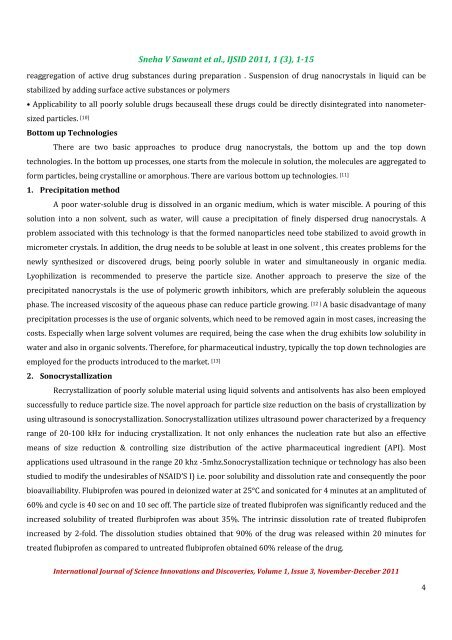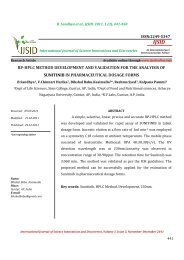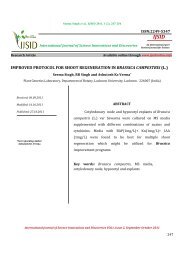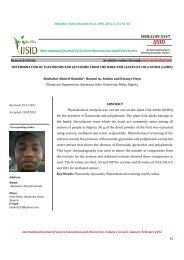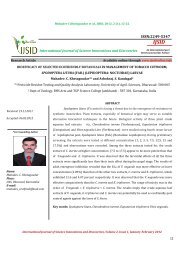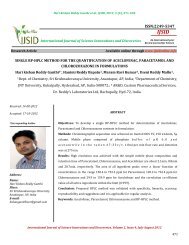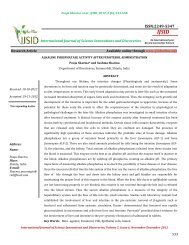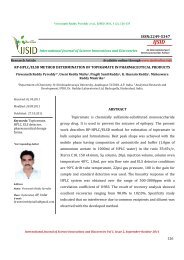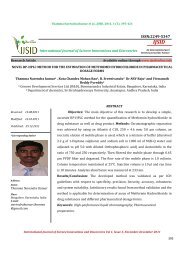drug nanocrystals: novel technique for delivery of ... - Ijsidonline.info
drug nanocrystals: novel technique for delivery of ... - Ijsidonline.info
drug nanocrystals: novel technique for delivery of ... - Ijsidonline.info
You also want an ePaper? Increase the reach of your titles
YUMPU automatically turns print PDFs into web optimized ePapers that Google loves.
Sneha V Sawant et al., IJSID 2011, 1 (3), 1-15reaggregation <strong>of</strong> active <strong>drug</strong> substances during preparation . Suspension <strong>of</strong> <strong>drug</strong> <strong>nanocrystals</strong> in liquid can bestabilized by adding surface active substances or polymers• Applicability to all poorly soluble <strong>drug</strong>s becauseall these <strong>drug</strong>s could be directly disintegrated into nanometersizedparticles. [10]Bottom up TechnologiesThere are two basic approaches to produce <strong>drug</strong> <strong>nanocrystals</strong>, the bottom up and the top downtechnologies. In the bottom up processes, one starts from the molecule in solution, the molecules are aggregated to<strong>for</strong>m particles, being crystalline or amorphous. There are various bottom up technologies. [11]1. Precipitation methodA poor water-soluble <strong>drug</strong> is dissolved in an organic medium, which is water miscible. A pouring <strong>of</strong> thissolution into a non solvent, such as water, will cause a precipitation <strong>of</strong> finely dispersed <strong>drug</strong> <strong>nanocrystals</strong>. Aproblem associated with this technology is that the <strong>for</strong>med nanoparticles need tobe stabilized to avoid growth inmicrometer crystals. In addition, the <strong>drug</strong> needs to be soluble at least in one solvent , this creates problems <strong>for</strong> thenewly synthesized or discovered <strong>drug</strong>s, being poorly soluble in water and simultaneously in organic media.Lyophilization is recommended to preserve the particle size. Another approach to preserve the size <strong>of</strong> theprecipitated <strong>nanocrystals</strong> is the use <strong>of</strong> polymeric growth inhibitors, which are preferably solublein the aqueousphase. The increased viscosity <strong>of</strong> the aqueous phase can reduce particle growing. [12 ] A basic disadvantage <strong>of</strong> manyprecipitation processes is the use <strong>of</strong> organic solvents, which need to be removed again in most cases, increasing thecosts. Especially when large solvent volumes are required, being the case when the <strong>drug</strong> exhibits low solubility inwater and also in organic solvents. There<strong>for</strong>e, <strong>for</strong> pharmaceutical industry, typically the top down technologies areemployed <strong>for</strong> the products introduced to the market. [13]2. SonocrystallizationRecrystallization <strong>of</strong> poorly soluble material using liquid solvents and antisolvents has also been employedsuccessfully to reduce particle size. The <strong>novel</strong> approach <strong>for</strong> particle size reduction on the basis <strong>of</strong> crystallization byusing ultrasound is sonocrystallization. Sonocrystallization utilizes ultrasound power characterized by a frequencyrange <strong>of</strong> 20-100 kHz <strong>for</strong> inducing crystallization. It not only enhances the nucleation rate but also an effectivemeans <strong>of</strong> size reduction & controlling size distribution <strong>of</strong> the active pharmaceutical ingredient (API). Mostapplications used ultrasound in the range 20 khz -5mhz.Sonocrystallization <strong>technique</strong> or technology has also beenstudied to modify the undesirables <strong>of</strong> NSAID’S I) i.e. poor solubility and dissolution rate and consequently the poorbioavailiability. Flubipr<strong>of</strong>en was poured in deionized water at 25°C and sonicated <strong>for</strong> 4 minutes at an amplituted <strong>of</strong>60% and cycle is 40 sec on and 10 sec <strong>of</strong>f. The particle size <strong>of</strong> treated flubipr<strong>of</strong>en was significantly reduced and theincreased solubility <strong>of</strong> treated flurbipr<strong>of</strong>en was about 35%. The intrinsic dissolution rate <strong>of</strong> treated flubipr<strong>of</strong>enincreased by 2-fold. The dissolution studies obtained that 90% <strong>of</strong> the <strong>drug</strong> was released within 20 minutes <strong>for</strong>treated flubipr<strong>of</strong>en as compared to untreated flubipr<strong>of</strong>en obtained 60% release <strong>of</strong> the <strong>drug</strong>.International Journal <strong>of</strong> Science Innovations and Discoveries, Volume 1, Issue 3, November-Deceber 20114


